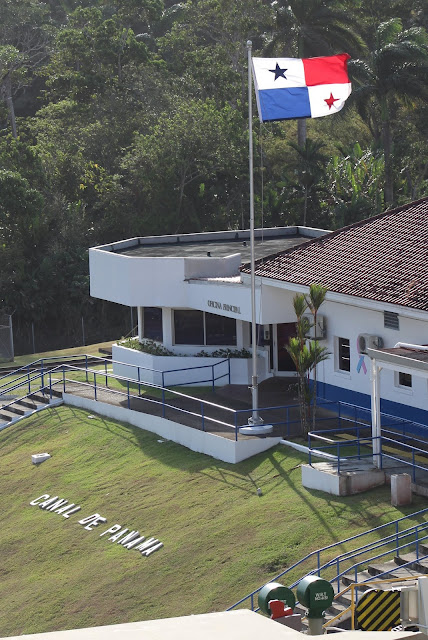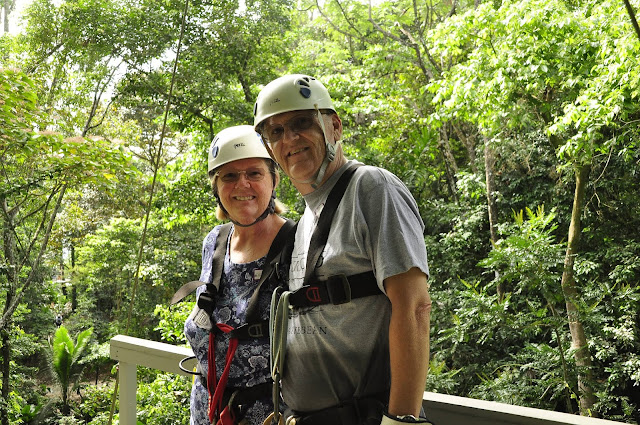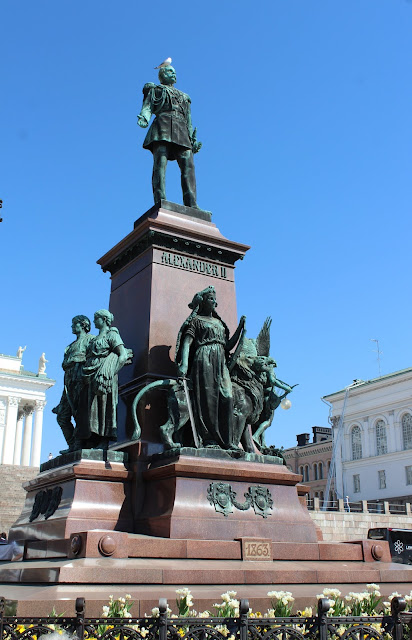After a day at sea, our first stop on the cruise was Charleston, South Carolina. Since we’d spent time there before, we just did a city tour that
included a historic mansion, the Manigault House. The family was one of the richest in the colonies at the time of the Revolutionary War. We
also enjoyed walking around the city and through the marketplace. Leaving Charleston, we had a sea day before arriving in New York City.
included a historic mansion, the Manigault House. The family was one of the richest in the colonies at the time of the Revolutionary War. We
also enjoyed walking around the city and through the marketplace. Leaving Charleston, we had a sea day before arriving in New York City.
 |
| Manigault House in Charleston |
It was awesome to be docked with a view of the Statue of Liberty from our balcony. Having spent time in the big apple previously, we opted to
go to a Broadway show. We took the ferry then subway to Times Square, a couple blocks from the Stephen Sondheim Theater. We saw
“Beautiful”, the Carole King story. It was outstanding! I’ve been a fan of hers since my college days when Tapestry was the big album. But I
didn’t know all the 60’s pop songs she had written early in her career. When we exited the theater, it was pouring rain. Luckily we didn’t have
far to catch the subway downtown and it stopped raining before we had to walk to the ferry dock.
go to a Broadway show. We took the ferry then subway to Times Square, a couple blocks from the Stephen Sondheim Theater. We saw
“Beautiful”, the Carole King story. It was outstanding! I’ve been a fan of hers since my college days when Tapestry was the big album. But I
didn’t know all the 60’s pop songs she had written early in her career. When we exited the theater, it was pouring rain. Luckily we didn’t have
far to catch the subway downtown and it stopped raining before we had to walk to the ferry dock.
 |
| View from our stateroom |
Our next stop was Newport, Rhode Island. After a terrible time getting ashore (Princess was not well prepared to tender all the passengers), we
went on a tour that drove along the beautiful coastline past the many mansions there. We toured one, the Oaks, that was an example of the
excesses of the rich in the gilded age. Now most of the mansions are owned by a conservancy. The town looked like a place we’d like to
return to visit again with more time. There are many colonial era buildings as well as touristy things to do there. While we were there they
were preparing to the Newport Jazz Festival, one of the biggest in the country.
went on a tour that drove along the beautiful coastline past the many mansions there. We toured one, the Oaks, that was an example of the
excesses of the rich in the gilded age. Now most of the mansions are owned by a conservancy. The town looked like a place we’d like to
return to visit again with more time. There are many colonial era buildings as well as touristy things to do there. While we were there they
were preparing to the Newport Jazz Festival, one of the biggest in the country.
 |
| Revolutionary era guide |
 |
| Granary Burying Ground, Boston |
The next day we arrived in Boston, a place we had also visited previously. So we did a guided walk along the Freedom Trail. Then we lunched on a
lobster roll and walked through Chinatown and back to the ship. From Boston we headed to Bar Harbor, Maine. First we walked around, including a
walk to an island that you can only walk to during low tide. Later in the day we saw the trail was covered by the sea. Then we took Oli’s Trolley into
Acadia National Park. What a beautiful park! The coastline is very rugged and the whole area is green and forested. We went to the top of Cadillac
Mountain, the highest point on the eastern seaboard. Although it is only 1500 feet elevation (not even close to being a mountain by Utah standards),
the view was spectacular. There were wild blueberries along the hillside that people were picking too. When we went back into the town, I enjoyed
the many shops. Bar Harbor is definitely a nice vacation spot.
lobster roll and walked through Chinatown and back to the ship. From Boston we headed to Bar Harbor, Maine. First we walked around, including a
walk to an island that you can only walk to during low tide. Later in the day we saw the trail was covered by the sea. Then we took Oli’s Trolley into
Acadia National Park. What a beautiful park! The coastline is very rugged and the whole area is green and forested. We went to the top of Cadillac
Mountain, the highest point on the eastern seaboard. Although it is only 1500 feet elevation (not even close to being a mountain by Utah standards),
the view was spectacular. There were wild blueberries along the hillside that people were picking too. When we went back into the town, I enjoyed
the many shops. Bar Harbor is definitely a nice vacation spot.
 |
| Acadia National Park shoreline |
 |
| View from Cadillac Mountain, Acadia National Park |
As we continued north we entered Canadian waters for our first stop, St. John, New Brunswick. Although we went on a tour, there was not much of
note to make the area interesting. The tour guide did her best, like pointing out the maple leaf on McDonald’s golden arches. We saw a Martello
tower, which is a round brick fort that was significant in the War of 1812. Also, the Bay of Fundy where St. John is located has the biggest tide
fluctuation on the planet. This causes the river that flows into the bay to have a “reversing rapids”, a unique phenomenon where the bay’s water
level goes from above to below the river’s level so the flow reverses itself four times a day. But to really appreciate it, I think you’d have to watch it
for hours, which we didn’t.
note to make the area interesting. The tour guide did her best, like pointing out the maple leaf on McDonald’s golden arches. We saw a Martello
tower, which is a round brick fort that was significant in the War of 1812. Also, the Bay of Fundy where St. John is located has the biggest tide
fluctuation on the planet. This causes the river that flows into the bay to have a “reversing rapids”, a unique phenomenon where the bay’s water
level goes from above to below the river’s level so the flow reverses itself four times a day. But to really appreciate it, I think you’d have to watch it
for hours, which we didn’t.
 |
| Martello Tower, St. John. NB |
Halifax, Nova Scotia, was a nicer port to visit. We walked through town to the Provincial Governor’s Residence where they have a tour and a
changing of the guards complete with bagpipes. Then we went to the Public Gardens which was a very pretty space. We ended up at the
Harbourwalk, a very nice boardwalk that stretches for two miles along the waterfront. Being a Canadian holiday when we were there, lots of
people and street performers were there along with the shops and restaurants. It made a fun afternoon.
changing of the guards complete with bagpipes. Then we went to the Public Gardens which was a very pretty space. We ended up at the
Harbourwalk, a very nice boardwalk that stretches for two miles along the waterfront. Being a Canadian holiday when we were there, lots of
people and street performers were there along with the shops and restaurants. It made a fun afternoon.
 |
| changing of the guard, Hslifax, NS |
 |
| Halifax Public Gardens |
Continuing up the Canadian coast we stopped at the town of Sydney on Cape Breton. We took an excursion there to the Fortress of Louisbourg,
a National Historic Site from the mid 1700’s. It was an important fortification in the struggle between the French and the British for control of the
area, and has been reconstructed to its original look, complete with costumed actors to demonstrate skills of the era. It is reminiscent of
Williamsburg, Virginia, on a smaller scale and with smaller crowds. When we returned to the town we walked around and along the shoreline to
enjoy the pretty area.
a National Historic Site from the mid 1700’s. It was an important fortification in the struggle between the French and the British for control of the
area, and has been reconstructed to its original look, complete with costumed actors to demonstrate skills of the era. It is reminiscent of
Williamsburg, Virginia, on a smaller scale and with smaller crowds. When we returned to the town we walked around and along the shoreline to
enjoy the pretty area.
 |
| Cape Breton |
 |
| Fortress of Louisborg |
 |
| Fortress of Louisborg |
 |
| Fortress of Louisbourg |
The last stop on our cruise was Quebec. I had heard about what a picturesque city it is, and I was not at all disappointed. From the quaint streets of
the lower town to the majestic Chateau Frontenac historic hotel that crowns the upper city, the entire area is magnificent. The first day we went to the
Museum of Civilization, which seemed like a weird collection of miscellany plus good exhibits about the First Nation peoples. The next day we
disembarked the ship and headed to a bed and breakfast for three additional days. This gave us plenty of time to explore the city and the area. We
took a tour that went to Montmorency Falls which is about 100 feet taller than Niagara just not nearly as wide and massive. We also went to the
Basilica of Sainte Anne de Beaupre and the Île d’ Orleans, the island across the Saint Lawrence River that is mainly agricultural. The next day we
went on a guided walking tour of the city and learned a lot about the history of the area. We also learned that the mighty St. Lawrence River, large
enough to dwarf a mega cruise ship, completely freezes over in winter. No wonder there are so many tourists there in summer; I wouldn’t want to
go in the winter months. The locals love to dine on the sidewalk patios of the restaurants of the street where we stayed (Grande Allee Est), enjoying the nice weather. We sat on a bench for a while to see how long it would take before we heard some English speakers; it took ten minutes. The people that work in the tourist areas are all bilingual, so not speaking French was not a problem for us. The last day we toured the Citadelle de Quebec that sits on the upper cliffs and has a magnificent view of the river. We also went to the Fort Museum and ate some poutine (can’t go to Canada without eating some local cuisine). The Quebec airport is rather small, and we had to take an 80 seater to Toronto to make the connection back to Salt Lake. We happily returned home to the kids and grandkids that took care of things in our absence and the dogs that missed us the most.
the lower town to the majestic Chateau Frontenac historic hotel that crowns the upper city, the entire area is magnificent. The first day we went to the
Museum of Civilization, which seemed like a weird collection of miscellany plus good exhibits about the First Nation peoples. The next day we
disembarked the ship and headed to a bed and breakfast for three additional days. This gave us plenty of time to explore the city and the area. We
took a tour that went to Montmorency Falls which is about 100 feet taller than Niagara just not nearly as wide and massive. We also went to the
Basilica of Sainte Anne de Beaupre and the Île d’ Orleans, the island across the Saint Lawrence River that is mainly agricultural. The next day we
went on a guided walking tour of the city and learned a lot about the history of the area. We also learned that the mighty St. Lawrence River, large
enough to dwarf a mega cruise ship, completely freezes over in winter. No wonder there are so many tourists there in summer; I wouldn’t want to
go in the winter months. The locals love to dine on the sidewalk patios of the restaurants of the street where we stayed (Grande Allee Est), enjoying the nice weather. We sat on a bench for a while to see how long it would take before we heard some English speakers; it took ten minutes. The people that work in the tourist areas are all bilingual, so not speaking French was not a problem for us. The last day we toured the Citadelle de Quebec that sits on the upper cliffs and has a magnificent view of the river. We also went to the Fort Museum and ate some poutine (can’t go to Canada without eating some local cuisine). The Quebec airport is rather small, and we had to take an 80 seater to Toronto to make the connection back to Salt Lake. We happily returned home to the kids and grandkids that took care of things in our absence and the dogs that missed us the most.
 |
| Chateau Frontenac |
 |
| Montmorency Falls |
 |
| Old town Quebec |
 |
| Upper and lower Quebec |
 |
| Quebec city walls |
 |
| Quebec from Citadelle de Quebec |











































































